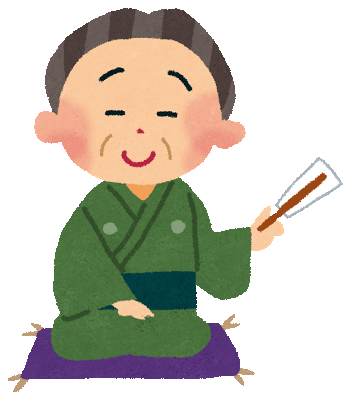日本(和)の世界を英語で説明してみよう!
Tweet第4回(更新日:2014年03月03日)
「落語」を英語で説明しよう

「落語」は江戸時代(1603-1867)に発達した寄席演芸で、寄席と呼ばれる演芸場で演じられます。落語家は着物姿で高座という舞台に座り、主に対話形式で語呂合わせや洒落を用いながら滑稽な話を独演します。話の終わりには“オチ”がつくのが特徴です。小道具には扇子や手ぬぐいが使われます。落語家はこれらを色々なものに見立てながら、観客を想像の世界へ導くのです。
落語は男性が語るための改良が重ねられてきた話芸で、歌舞伎と同様に、男性が女性をも演じられるように工夫されています。しかし、最近では、女性の落語家も表れて話題になっています。
さて、それでは「落語」を英語で説明してみましょう。
Rakugo, a vaudeville*1 performance developed in the Edo Period (1603-1867), is performed in entertainment halls called yose. The rakugo artist sits on stage on a dais*2, wearing a kimono, and performs his humorous peice solo, with puns*3 and wordplay*4, usually in the form of a dialogue*5. The main feature is applying the punch line*6 at the end of the piece. Folding fans and hand towels are used for props*7. In making these sorts of props come alive; rakugo artists lead the spectators*8 into an imaginative world. Rakugo is a conversational art form in which the refinements that have piled up come from men doing the reciting*9; it uses the same device as Kabuki with men taking female parts. However, recently female rakugo artists have emerged and are much talked about.
*1vaudeville: 寄席演芸
*2dais: 高座、演壇
*3puns: だじゃれ、語呂合わせ(punの複数形)
*4wordplay: しゃれ
*5dialogue: 対話
*6punch line: オチ
*7props: 小道具(propの複数形))
*8spectators: 観客(spectatorの複数形)
*9reciting: 朗読
「落語」のようなキレがあってオチのある話術は、外国人相手にも通用しそうですよね。次回もどうぞお楽しみに。
執筆者:こまたん
(次回の内容や更新情報などは、こまたんのツイッターでお知らせしてます)

